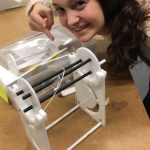- Beginning Sketches
- Switching from gears to a rotation track
- All of the acetal pieces for our first attempt windlass.
- The physical mock up for our first model.
- Solidworks image of our first side piece attempt.
- Trying to figure what adjustments to make for success.
- Very close to the final model, lacking a handle, longer cross supports on the bottom, and an outer track.
- The final well windlass!
For our windlass one of the first things we knew we should do was shorten the delrin rod. We were able to divide it in three, effectively controlling the length variable within the beam deflection formula. A factor that proved a challenge which we could not alter was the weight variable. We could not alter the water bottle that we needed to lift. I think that our structure was sturdy when considering its ability to hold up the pressure going down on it caused by the water. This was mostly due to our side pieces being mostly single units with a large amount of our given surface area. A way in which the structure was weak was that that the delrin rods were still able to bend a lot. The fact that our handle was attached to the outside of an 8 cm circle meant each single rotation pulled the bottle up a significant amount. This allowed us to slowly and steadily raise the bottle, without needing to rotate a handle circling a smaller circumference many more times and fairly quickly in comparison.
We began by thinking about how long and tall our design would need to be based on the given constraints. We started calculating right away, considering our limited materials and trying to figure out the best way to distribute the acetal. First we were thinking about gears, because we were interested in having a handle that would be able to turn from on top rather than on the side, where we would be limited by the height off of the table. We thought about which kinds of connections (heat stake, tight fit, and piano wire) we could use to make our early brainstorm work and sketched rapidly. Then we thought of a new way the piece spanning the table could rotate in simpler side pieces. We realized we had to have our structure high enough off of the table that it did not obstruct a convenient handle. So we began sketching new side pieces, the idea being to create a sort of track for the middle structure to sit in and easily rotate, without falling out of said track. Moving forward our windlass did not change a lot, we worked to make the amount of plastic we had give us the sturdiest version of our design. Our almost final version was iterated by making the windlass span a bit wider and adding the bottom fixed cross supports once we realized the bottle was not obstructed from raising high enough. This last edit made it so our windlass’ tracks would keep our rotating piece from popping out when weight stress was applied and so that the windlass would not easily slip and fall into the space between the tables. We had success with our final version, but i think additional rings to stop the delrin rods from bending and table hooks as shown in some of our sketches would be good improvements.
We ended up using 483 out of our available 500 cm^2 acetal. We used varying thicknesses of plastics and were able to conserve material by cutting two of the c shaped tracks out of our side supports and cutting our circles that attach to the delrin out of the arcs in the side pieces. I think we could have conserved even more plastic, reducing from our large side pieces. Doing so would have allowed us to make possible improvements if there had been more time.










I really like the creative design of your windlass and how unique it was when compared to everyone else’s. Also, cutting the “C” shaped pieces out of your solid sides was an effective way to meet the Delrin surface area limit. I was surprised how much the Delrin rods bent towards each other when pulling up the bottle, but because the rod is fairly flexible, I did not think it seemed too problematic. Did you guys worry about the rods breaking under the force of the string/bottle?
I think your idea to use a circle rotating in a rail to be really innovative and cool! I thought it was really different to all the other projects that were created.